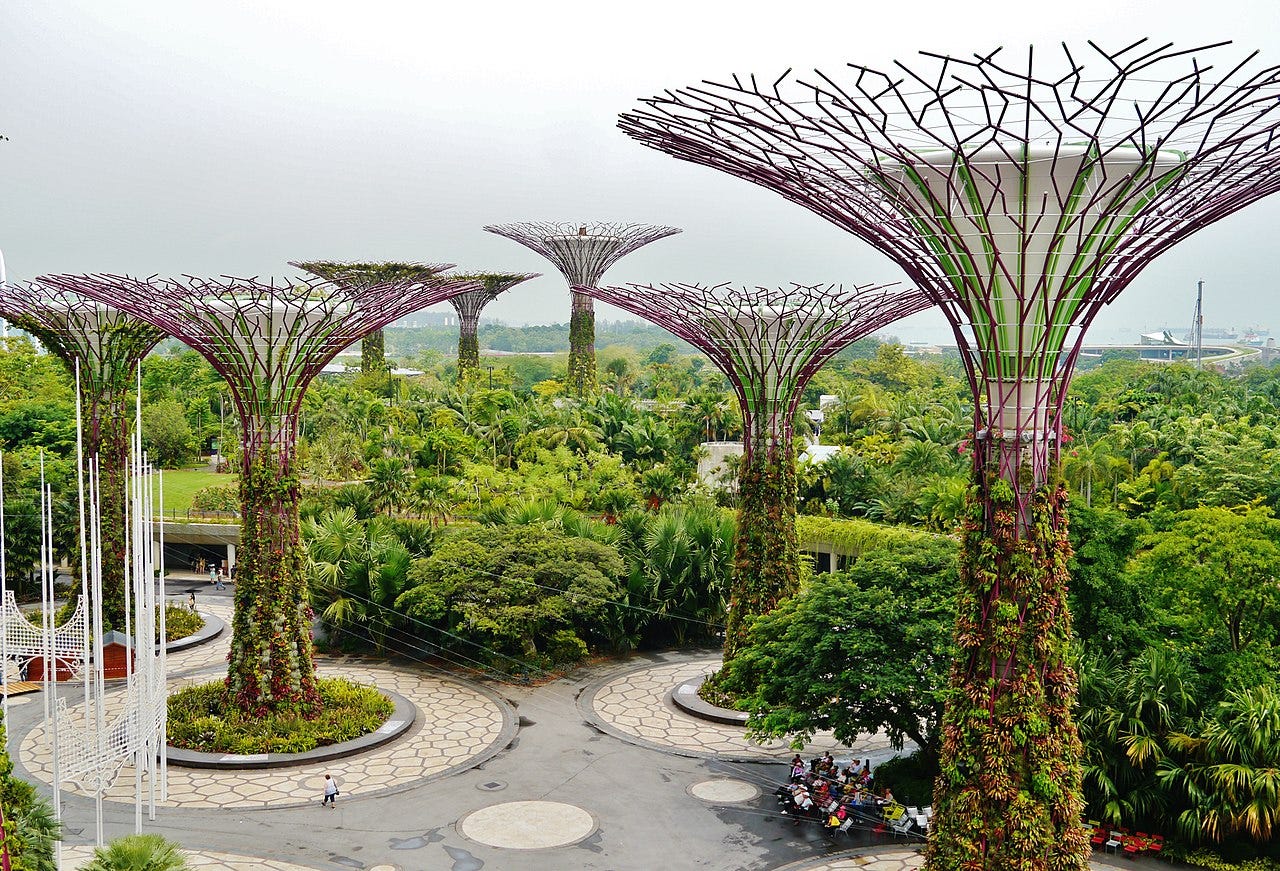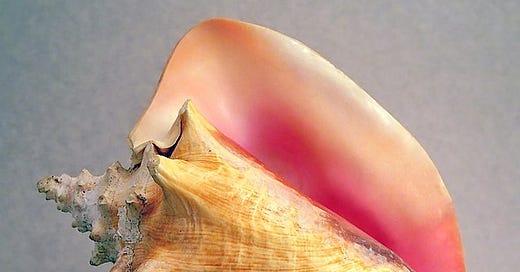The Conscious Emulation of Life’s Genius
7/6/23 – Biomimicry and the art of living on Earth more gracefully

Hello everyone:
The Fourth of July has come and gone, bringing with it our love of fiery spectacle and, not coincidentally, the hottest day on Earth ever recorded. In fact, it may have been the hottest day in the last 125,000 years. It’s another difficult reminder that human history is now Earth history.
The best fireworks this time of year are fireflies, which are in steep decline: Please give them a hand by letting some lawn grow tall, turning outside lights off, and holding off on pesticides.
As always, please remember to scroll past the end of the essay to read some curated Anthropocene news. I lean a lot on work from the Guardian this week, because they keep putting out excellent reporting on our transformed world. I recommend you rely on their environmental reporting, especially their Age of Extinction series, and donate if you can.
Now on to this week’s writing:
Have you, like me, ever been on a walk and wondered why the world that’s been built for us these past few centuries doesn’t resemble or fit into the natural world? Why we aren’t gracefully aligned with forests, streams, and soil rather than crushing them under our weight? Why we bulldoze what is most valuable and poison ourselves in the process? Why our energy sources are fiery and brutal instead of quiet and gentle? Like a child, have you ever crouched to a spiral seashell and thought, I want a house like this, knowing that the architecture of that shell inhabits the world with perfect form and innocence?
I had plans for a different essay this week, but set it aside after Heather and I listened to a beautiful podcast conversation, “Biomimicry, an Operating Manual for Earthlings,” between Krista Tippett of On Being and Janine Benyus. Take the time to listen if you can.
Benyus is an ecologist, author, teacher, and consultant devoted to communicating the importance of biomimicry for the survival of humanity and our fellow species. Her 1997 book, Biomimicry: Innovation Inspired by Nature, laid the groundwork. Then she co-founded the non-profit Biomimicry Institute, where education and funding support biomimetic initiatives; AskNature, a “database of biological intelligence organized by design and engineering functions;” and Biomimicry 3.8, a biological intelligence consulting and training company that works with major corporations, NGOs, universities, government agencies, among others, to “create more sustainable products and services, build more generously, design with supreme resilience, and be inspired by nature to create conditions conducive to life.”
Somehow, I’ve missed out on this visionary solution for what ails us, and so this week I’ll dive in and introduce it to you too.
What’s biomimicry? In her book, Benyus calls it “the conscious emulation of life’s genius.” In practice, it’s about creating processes and products that are not merely inspired by nature but are as ecologically efficient and regenerative. At its fullest, then, biomimicry is nothing less than a way to reimagine and rebuild our world on ecological principles. This sounds vague, but in fact Benyus is talking not about environmentalism per se but about practical principles of design.
Why? Because over the last few hundred years we’ve designed our way into a planetary crisis. Now we have to quickly design our way back out. What we do, and how we do it, must change.
Krista Tippett introduces the biomimicry concept this way:
It’s a design discipline that takes the natural world as mentor and teacher, inviting the intelligence and wisdom of biology and ecology around tables where previously only engineering and construction and material sciences sat. Biomimicry inquires into the mechanisms by which nature solves problems — and by the way, performs what appear to us as miracles in every second all around: running on sunlight, fitting form to function, recycling everything, relentlessly creating “conditions conducive to life.”
What are the design principles? Ask your neighbors. Ask the mussels and mangroves about water filtration; ask the beavers and bison about habitat restoration; ask the conchs, caddisfly larvae, and coccolithophores about making beautiful architecture that’s also perfectly functional and completely nontoxic. “We are surrounded,” Benyus reminds us, “by geniuses.” They are the ever-changing network of organisms who have run the world for a few billion years with a handful of guiding principles.
“Life,” Biomimicry 3.8 says, “creates conditions conducive to life” by:
evolving to survive
adapting to changing conditions
being locally attuned and responsive
using life-friendly chemistry
being resource efficient
integrating development with growth
Each of these six guiding principles has a few sub-principles, as the diagram below shows. It’s worth taking a minute to read them to understand how the concept of biomimicry is being used to translate the natural world for the corporate managers who may be more interested in shell companies than seashells:
The Anthropocene is the result of modern humans (who thought they were geniuses) insisting we can build a new world on an antibiotic foundation of combustion and capital rather than simply continuing to nestle our existence within the ecologies that raised us. We have been obsessed with constant growth instead of invested in healthy development. In the interview, Benyus says that modern humans have acted like “toddlers with matches.”
As funny as that image is, it runs deep. Some Native American traditions, too, have long recognized that humans are younger siblings to other species. As the great Robin Wall Kimmerer put it in an essay on our modern loneliness as a species,
For much of humans’ time on the planet, before the great delusion, we lived in cultures that understood us not as “masters of the universe” but as what my Haudenosaunee neighbors call “the younger brothers of creation.”
Our big-brained evolutionary path toward tool-making and god-dreaming cognition has meant that, unlike other species born into an ancient understanding, we don’t know how to live. We have to figure it out as a group, because this blessing we call complex consciousness is also a deficit of innate knowledge. We need good rules to live by.
In the modern era, rather than learning from the life around us as Indigenous cultures have long done, we have imagined and invented abstract behaviors that reflect a fundamental ignorance of the principles of life. Meanwhile, the moss, hawks, viruses, and cacti who are exquisitely designed to thrive are suffering from our mistakes.
The age we live in now, with all of its existential harms, is the result of believing that our imaginations and inventions are a sign of maturity. But if we don’t learn to practice large-scale modesty and restraint, the natural world will continue to fade as we fan the flames of the artificial one we’ve created in its place.
So, how does biomimicry come to the rescue? By asking the right questions. As Benyus tells Tippett, life has been figuring things out for 3.8 billion years, and biomimicry taps into that knowledge:
it’s an innovation practice where the people who make our world, the designers and the engineers and the architects and the construction workers, when they go to solve a problem, they say, “What in the natural world has already solved this problem?” And then they try to emulate that organism or that ecosystem and hopefully come up with something that helps us live here more gracefully.
I love that idea that what we’re after is to “live here more gracefully.” It acknowledges our awkward and alien presence on our own planet, distanced from all that is real and true, but more importantly it sets a clear and open-hearted goal that touches everything we do and all that we are. We want to be graceful with each other, and we want to be graceful amid the community of life.
And though she confesses to being often “impatient with the toddler,” Benyus is enthusiastic about the progress she and her organizations have helped make:
we have spent 250 years of Western science asking about nature. And now, we are starting to ask to learn from nature. It’s exciting. It’s a completely different way to do science, to learn from rather than just about. That’s the switch. That’s really the profound switch.

I can scarcely begin to give you a sense of the scale of the profound switch that’s possible here, because what we’re learning from is as vast and complex as the planet – from bacterial chemistry to geologic formations – and the applications of that knowledge are as numerous as our Anthropocene needs. (Someone would do well to begin a weekly Substack discussion of the practical applications of biomimicry.) I’ll provide a very quick overview before letting you loose to listen to the podcast, watch the video below, and explore the deep resources at AskNature.org, Biomimicry.org and Biomimicry.net.
Benyus began her research for her book with the assumption that someone, somewhere must be designing solar panels to work like leaves, but that wasn’t the case. Still today, 25 years later, silicon solar electric cells aren’t as efficient or useful as organic cells in a photosynthetic leaf, which doesn’t require manufacturing, recycles CO2 into life-giving oxygen, produces no unwanted waste, and biodegrades to feed the forest floor.
But researchers have learned from leaf cell structures to make silicon cells more efficient, and various institutions around the world are racing to build leaf-like solar fuel cells that produce carbon-neutral burnable fuels. I’m not convinced we should be burning anything for energy anymore, but the effort toward biomimicry is impressive. And in the big picture, the fact that solar has suddenly become the cheapest energy to build and distribute is remarkable, not least because it signals a switch from the harshness of burning fossil fuels toward the gentleness of photosynthesis.
I wrote recently about the problem of “carbon capture,” which is largely a multi-billion-dollar fossil fuel industry distraction to keep us hooked on their products, but one carbon capture proposal may prove the exception. Benyus mentions in the interview a company called Blue Carbon, which might revolutionize the cement/concrete industry while also sequestering huge amounts of CO2. Their “geomimetic” process uses only waste concrete (or similar waste products) and captured CO2 (from any source) to produce an artificial limestone (CaCO3) that permanently locks up the CO2 and provides the bulk of the material for new concrete. If true and scalable to global proportions, it will be an elegant and important solution for much of what ails us.
There’s an excellent sample of biomimetic solutions on a page at Ask Nature that marks the 25th anniversary of Biomimicry: Innovation Inspired by Nature. They range from the Land Institute’s decades-long effort to breed an ecologically-vital perennial mix of grain crops on the American prairie to the redesigning of wind turbines with features that mimic owl wings or shark skin. You can explore water purification systems based on forest microbial communities, building insulation made with fungal mycelium, high-speed trains shaped like kingfishers, showerheads designed like spiraling sunflower heads, and small-scale hydroelectric generators modeled on how trout swim.
I want to pause here and remember that biomimicry is, at heart, about design and process, not about things. We have to be careful not to spend our enthusiasm on technological solutions per se, but on solutions that are as eco-friendly as they are tech-savvy. If their resemblance to natural systems and features is holistic rather than merely aesthetic (helicopters shaped like dragonflies, for example), then we’re on the right track.
We live in a society that, for the most part, has been designed for us rather than by us. It largely serves those designers, who are often profit-driven and lost somewhere in what Kimmerer calls “the great delusion,” wherein the Earth is imagined as a lifeless collection of resources to be taken, sold, and discarded. But once you begin to see nature as our mentor and its geniuses as our teachers, and to acknowledge our status as a younger sibling in a community of biological elders, then that view of Earth as “resources” feels grotesque. You can’t live here gracefully and believe anything of the sort.
Finally, I want to note that like so many of us, Benyus had a childhood rich in outdoor play – “I’d wriggle out of my mom’s arms in the morning, she’d hand me a lunch bag and I’d be gone until she rang and rang and rang the bell” – and marked by the trauma of seeing her neighborhood paradise scraped down to the bone by a bulldozer. That tension between love and loss, she says, informs her work to this day.
It should inform ours too.
Along with listening to the On Being podcast, you can watch this video of Benyus talking about biomimicry (Leonardo DiCaprio was a producer.)
Thanks for sticking with me.
In other Anthropocene news:
For my Maine readers – but everyone should be paying attention – an excellent article in the Guardian about the upcoming ballot question that would put Maine’s two power companies out of business. Voters will be asked if they want to create a state-owned utility called Pine Tree Power, an agency that’s locally-owned, more responsive to customers, and more focused on the quick transition to renewable energy. Some towns and cities around the U.S. have created municipal power companies, but this would be the first time an entire state has taken the reins. Unsurprisingly, the foreign-owned power companies are spending millions of dollars on a blistering negative campaign. Utilities across the country are paying attention:
“This is one ship they don’t want to see launched,” said Kenneth Colburn, a former consultant with the global energy policy firm Regulatory Assistance Project, speaking about investor-backed utilities across the US. “Because it could turn into an armada.”
If you’re not already a subscriber to @Bill McKibben’s @The Crucial Years, you should be. Check out his two latest posts, “Major Questions,” on the Supreme Court and its undermining of democracy and environmental progress, and “No Human Has Ever Seen It Hotter,” about the news that recent days have been the hottest since. Be sure to scroll down to read all of his curated climate news as well. McKibben reports sensibly on the problems and solutions to the hot mess we’ve made of the world, and we should all be paying attention.
From the vital reporting of Elizabeth Kolbert at the New Yorker, “How Plastics Are Poisoning Us,” a short piece taking a deep look at the shocking scale and impact of microplastics in every aspect of the living world, not least in our own bodies.
Speaking of small and toxic, the Great Salt Lake in Utah is a small and toxic shadow of its former self. Like other salt lakes around the world, it is disappearing and taking uncounted lives with it. Wildlife and humans are both at risk. Higher water levels in the lake must be restored. The Post has a new piece on this, noting that the Mormon church is finally paying attention, and the Times carried a beautiful op-ed from Terry Tempest-Williams back in March.
Want some more motivation to become an activist against climate change? From Yale Climate Connections, a new study explains that for every tenth of a degree of warming we avoid, 100 million people won’t be subjected to the extreme temperatures and weather that come with being forced out of Earth’s “Goldilocks zone” of livable conditions.
From the Bulletin of Atomic Scientists, a long-form story about the environmental impacts of salmon farming in Chile. It’s not pretty.
And three more from the ever-vigilant Guardian:
Tired of summer humidity? What if you could power your house with it? Check out this report on a new technology that converts humidity in the air into power. It’s still very much in the tiny-scale testing process, and it may prove to be a costly distraction from the reliable solar and wind sources we’re investing in now, but it’s nonetheless fascinating.
In bigger and darker news, the long-predicted intensification of climate change seems to be upon us, as viewed in spikes in air and ocean temperature, and sharp reductions in sea ice around both Poles. Partly this seems due to the shift from La Nina to El Nino conditions. Weather isn’t climate, but the extraordinarily harsh heat experienced by people in Mexico, Texas and the Gulf states, and India – to name a few – is very much in line with what’s expected from our greenhouse gas emissions.
And in smaller but even darker news, a study finds that PFAS are prevalent in store-bought kale, almost regardless of which brands and which stores it came from. This is not a real surprise, given that PFAS are found just about everywhere. One unpleasant detail, though, is that the organic kale had the highest levels. If you haven’t read my writing on PFAS, here’s a quick summary from the article:
PFAS are a class of about 15,000 compounds typically used to make products across dozens of industries resistant to water, stains and heat. They are called “forever chemicals” because they do not naturally break down, and are linked to cancer, kidney disease, liver conditions, immune disorders, birth defects and other serious health problems.








Thanks, as usual, Jason. Great stuff. As a former (recovering) print journalist, I'm finding myself drifting away from daily news, especially its political coverage: the blow-by-blow tribalism, the insider antics, the puffery. But having regularly read many newspapers for most of my life, I've found none that covers nature better than The Guardian (which I have in the past supported financially). Its biodiversity coverage is damned good for a newspaper. And as you probably know, its plain coverage of ecosystems is in a league of its own among newspapers. The Guardian has a butterfly correspondent, for example! In so many other newspapers, nature is relegated to afterthoughts or novelties, rather than its rightful, lofty place in the human experience. In any event, thanks again for your exhaustive work this week -- I know it takes time and brain power on your part. I'm grateful for it all.
Great essay!. Just as warming is happening so fast we can see it in real time, Humanity's explorations of the treasure house of biological solutions to problems, (fine tuned by four billion years of trial and error experiments) is gathering momentum before our eyes.. I wrote about this recently in a story about heat and Humanity's study of how life has evolved elegant solutions to living in very hot environments.
We better learn from Nature, we're running out of time.